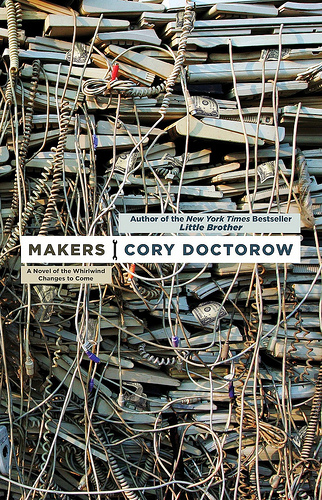Makers by Cory Doctorow: An Amateur Review

My friend Ric, who I’m sure is the biggest geek in idyllic Bali, introduced “Makers”, the most recent novel by author, blogger and activist Cory Doctorow to me over a couple of beers. “The only thing standing between now and an explosion of innovation thanks to 3D printers is the ability to print circuits with them”, he enthused with borderline manic enthusiasm. He reasons that when we can actually use 3D printers to print other 3D printers, a crucial piece of the dawn of robots will have been made. Hooked, I decide to read the book. I downloaded Makers (legally of course), and having read this remarkable book, feel that a review is justified.
This is my first book review, and I have avoided reading other reviews in order to avoid falling into the trap of groupthink.
I haven’t read science fiction set in our time, so it is refreshing to read a yarn about our world and where it’s going. It helps us see about the world that we live in differently, which is a gift.
There are 3 parts to this story. Part 1 begins with a press conference. Suzanne Church is a tech journalist who makes the hard decision to leave her job in order to chronicle an innovative experiment by the corporate giant Kodacell, which in the author’s universe is the result of a merger between Kodak and Duracell. The experiment is for Kodacell to fund and give logistical and business support to garage innovators nationwide. She is ‘embedded’ with the affable and creative geeks-in-a-shopping-mall duo of Lester & Perry as they seek to invent cool things out of junk in an abandoned mall in Florida, and she is our guide through the first part of the story.
Cory Doctorow makes the incremental progress of invention and iteration smooth as the mechanical hum from a hardware workshop. The first half flies by from Kodacell’s press announcement to Suzanne’s adventures in Florida. His vision of working out of a hardware hackers’ den amid loads of useful junk is techno-utopianism, and his descriptions of fun ideas with the (fictional) Boogie Woogie Elmo are a joy to read. We don’t really know why Lester and Perry, the engineering geniuses around whom the story revolves, choose to work for Kodacell. They already made a decent living and have little interest in building companies, only cool toys. This question becomes pressing later when evil big business threatens to destroy everything that they worked for. Without a clear reason why, I find it difficult to empathize with the duo when they rail against the influence of business on their life and affairs when they were content earlier on to accept this influence. The hole in the plot probably isn’t a big deal, as with most science fiction, the best features of the stories are in the ideas, of which there are many.
Lester and Perry have their own 3D printer, and story begins with them printing collectibles for the rich. Modern 3D printers are already available for as little as a few hundred dollars, so it’s fun to envision a near future when practically every home will have a 3D printer, as imagined by Cory Doctorow. There’s a take on this theme that involves networking the 3D printers and bots to replicate dioramas that accept user-generated-content and permit user curation via upvotes and downvotes. Ambitious Foundation-esque scifi it ain’t, but the idea is modern in its accessibility, and no less enjoyable for it.
Something big happens at the end of Part 1, that propels us several years forward, and into parts 2 and 3. Economic deterioration and decay, of corporations, homes, infrastructure are a recurring theme throughout the book. 21st century detroit has spread across America, and nothing is spared from the winds of decay, not even Disney.
Lester and Perry’s tinkering put them on a collision course with Disney when one of their inventions inadvertently makes use of copyrighted material from the Magic Kingdom. This forms the premise of what takes place in parts 2 and 3. We are also introduced to Sammy, who is a senior executive at Disney responsible for one of the rides. It is he and Perry who are the chief protagonists through parts 2 and 3 of the story, but it is Perry who is the protagonist who starts and leads a mass movement that promises to rejuvenate a number of communities nationwide through a ride network with crowdsourced content that serves as a tourist magnet in each location, incurring the wrath of Disney and Sammy in the process.
The story sags for me in parts 2 and 3. The motivations of the characters are not convincing, and the enjoyable inventive fireworks from part 1 are largely absent. Perhaps it is intended as a realistic portrayal of what a movement, with all its egos, conflicting interests and struggles are like. We see Perry travel to different locations assisting local groups set up rides of their own, even meeting Hilda, who becomes his girlfriend and emotional rock. However, Perry is not happy playing leader to what he sees as a grassroots movement, and we are not afforded the chance to see what the experience of leading or participating in a movement is truly like.
If part 1 was an enjoyable foray into the excitement of invention, parts 2 and 3 should be considered a long, meandering but probably important lesson into what burden of responsibility a creative inventor has to bear sometimes.
Tweetcomments powered by Disqus